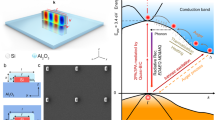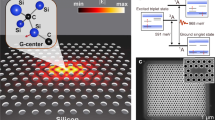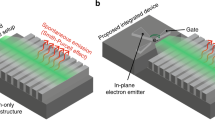Abstract
Adding optical functionality to a silicon microelectronic chip is one of the most challenging problems of materials research. Silicon is an indirect-bandgap semiconductor and so is an inefficient emitter of light. For this reason, integration of optically functional elements with silicon microelectronic circuitry has largely been achieved through the use of direct-bandgap compound semiconductors. For optoelectronic applications, the key device is the light source—a laser. Compound semiconductor lasers exploit low-dimensional electronic systems, such as quantum wells and quantum dots, as the active optical amplifying medium. Here we demonstrate that light amplification is possible using silicon itself, in the form of quantum dots dispersed in a silicon dioxide matrix. Net optical gain is seen in both waveguide and transmission configurations, with the material gain being of the same order as that of direct-bandgap quantum dots. We explain the observations using a model based on population inversion of radiative states associated with the Si/SiO2 interface. These findings open a route to the fabrication of a silicon laser.
This is a preview of subscription content, access via your institution
Access options
Subscribe to this journal
Receive 51 print issues and online access
$199.00 per year
only $3.90 per issue
Buy this article
- Purchase on Springer Link
- Instant access to full article PDF
Prices may be subject to local taxes which are calculated during checkout







Similar content being viewed by others
References
Canham, L. T. Silicon quantum wire array fabrication by electrochemical and chemical dissolution of wafers. Appl. Phys. Lett. 57, 1045– 1048 (1990).
Cullis, A. G. & Canham, L. T. Visible light emission due to quantum size effects in highly porous crystalline silicon. Nature 353, 335–338 ( 1991).
Wilson, W. L., Szajowski, P. F. & Brus, L. E. Quantum confinement in size-selected surface-oxidised silicon nanocrystals. Science 262, 1242– 1244 (1993).
Lu, Z. H., Lockwood, D. J. & Baribeau, J.-M. Quantum confinement and light emission in SiO 2/Si superlattices. Nature 378, 258 –260 (1995).
Hirschman, K. D., Tsybeskov, L., Duttagupta, S. P. & Fauchet, P. M. Silicon-based light emitting devices integrated into microelectronic circuits. Nature 384, 338–340 (1996).
Franzò, G., Priolo, F., Coffa, S., Polman, A. & Carnera, A. Room temperature electroluminescence from Er doped crystalline silicon. Appl. Phys. Lett. 64, 2235– 2237 (1994).
Leong, D., Harry, M., Reeson, K. J. & Homewood, K. P. A silicon/iron disilicide light-emitting diode operating at a wavelength of 1.5 µm. Nature 387, 686–688 (1997).
Nassiopoulos, A. G., Grigoropoulos, S. & Papadimitriou, D. Electroluminescent device based on silicon nanopillars. Appl. Phys. Lett. 69, 2267– 2269 (1996).
Bisi, O., Ossicini, S. & Pavesi, L. Porous silicon: a quantum sponge structure for silicon based optoelectronics. Surf. Sci. Rep. 38, 1–126 (2000).
Wolkin, M. V., Jorne, J., Fauchet, P. M., Allan, G. & Delerue, C. Electronic states and luminescence in porous silicon quantum dots: the role of oxygen. Phys. Rev. Lett. 82, 197–200 ( 1999).
Miller, D. A. Silicon sees the light. Nature 378, 238 (1995).
Iyer, S. S. & Xie, Y.-H. Light emission from silicon. Science 260, 40–46 ( 1993).
Silicon based optoelectronics. Mater. Res. Bull. 23(4), (1998).
Fauchet, P. M. The integration of nanoscale porous silicon light emitters: materials science, properties and integration with electronic circuitry. J. Lumin. 80, 53–64 ( 1999).
Yariv, A. Quantum Electronics 2nd edn (Wiley & Sons, New York, 1974).
Canham, L. T. in Frontiers of Nano-Optoelectronic Systems (eds Pavesi, L. & Buzaneva, E.) 85–98 (Kluwer Academic, Dordrecht, 2000).
Iacona, F., Franzò, G. & Spinella, C. Correlation between luminescence and structural properties of Si nanocrystals. J. Appl. Phys. 87, 1295 –1303 (2000).
Kovalev, D., Heckler, H., Polisski, G. & Koch, F. Optical properties of Si nanocrystals. Phys. Status Solidi 251, 871–930 (1999).
Kanemitsu, Y. & Okamoto, S. Quantum confinement and interface effects on photoluminescence from silicon single quantum wells. Solid State Commun. 103, 573–576 (1997).
Kanemitsu, Y. & Okamoto, S. Phonon structures and Stokes shift in resonantly excited luminescence of silicon nanocrystals. Phys. Rev. B 58, 9652–9655 ( 1998).
Degoli, E. & Ossicini, S. Quantum confined and interface states related visible luminescence in Si/SiO2 superlattices. Surf. Sci. (in the press).
Klimov, V. I., Schwarz, Ch., McBranch, D. W. & White, C. W. Initial carrier relaxation dynamics in ion-implanted Si nanocrystals: femtosecond transient absorption study. Appl. Phys. Lett. 73, 2603–2605 (1998).
Linnros, J., Galeckas, A., Lalic, N. & Grivickas, V. Time-resolved photoluminescence characterisation of nm-sized silicon nanocrystallites in SiO2. Thin Solid Films 297, 167 –170 (1997).
Shaklee, K. L., Nahaory, R. E. & Leheny, R. F. Optical gain in semiconductors. J. Lumin. 7, 284–309 ( 1973).
Kirstaedter, N. et al. Gain and differential gain of single layer InAs/GaAs quantum dot injection lasers. Appl. Phys. Lett. 69, 1226–1228 (1996).
Lingk, C. et al. Dynamics of amplified spontaneous emission in InAs/GaAs quantum dots. Appl. Phys. Lett. 76, 3507– 3509 (2000).
Blood, P. On the dimensionality of optical absorption, gain and recombination in quantum-confined structures. IEEE J. Quantum Electron. 36, 354–362 (2000).
Kovalev, D. et al. Optical absorption cross sections of Si nanocrystals. Phys. Rev. B 61, 4485–4487 (2000).
von Behren, J., Kostoulas, Y., Ucer, K. B. & Fauchet, P. M. The femtosecond optical response of porous, amorphous and crystalline silicon. J. Non-Cryst. Solids 198–200, 957 –960 (1996).
Jordan, V. Gain measurements of semiconductor laser diodes: requirements for wavelength resolution and sensitivity to noise. IEE Proc. Optoelectron. 141, 13–15 (1994).
Hvam, J. M. Direct recording of optical gain spectra from ZnO. J. Appl. Phys. 49, 3124–3126 ( 1978).
Acknowledgements
This work has been supported by the National Institute for the Physics of the Matter (INFM) through the LUNA project and the advanced research project RAMSES.
Author information
Authors and Affiliations
Corresponding author
Supplementary information
Rights and permissions
About this article
Cite this article
Pavesi, L., Dal Negro, L., Mazzoleni, C. et al. Optical gain in silicon nanocrystals. Nature 408, 440–444 (2000). https://doi.org/10.1038/35044012
Received:
Accepted:
Issue Date:
DOI: https://doi.org/10.1038/35044012
This article is cited by
-
Direct bandgap emission from strain-doped germanium
Nature Communications (2024)
-
Electrical properties of polyaniline (PANI)-porous silicon (PS) heterostructure
Polymer Bulletin (2024)
-
Prospects and applications of on-chip lasers
eLight (2023)
-
Room-temperature continuous-wave topological Dirac-vortex microcavity lasers on silicon
Light: Science & Applications (2023)
-
Room-temperature continuous-wave indirect-bandgap transition lasing in an ultra-thin WS2 disk
Nature Photonics (2022)
Comments
By submitting a comment you agree to abide by our Terms and Community Guidelines. If you find something abusive or that does not comply with our terms or guidelines please flag it as inappropriate.



